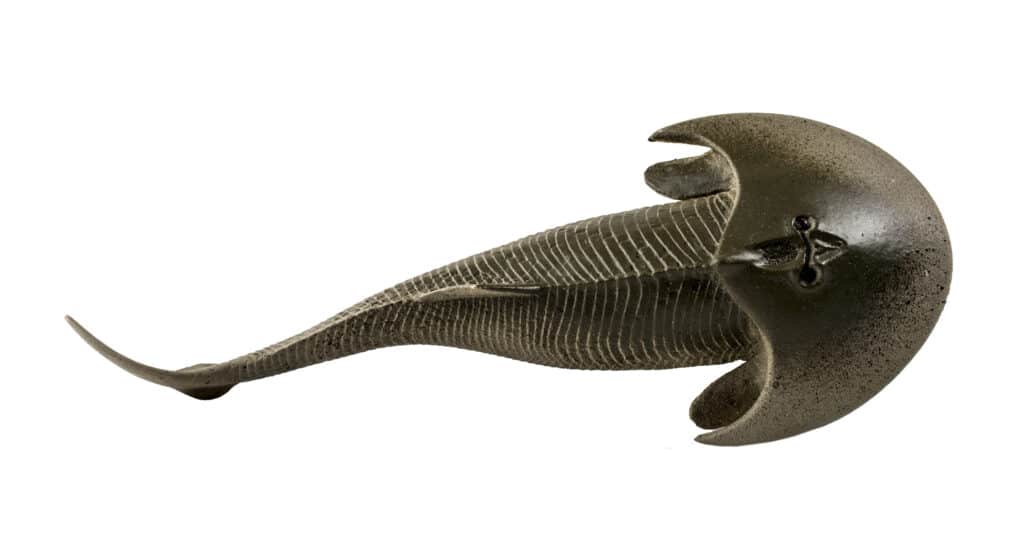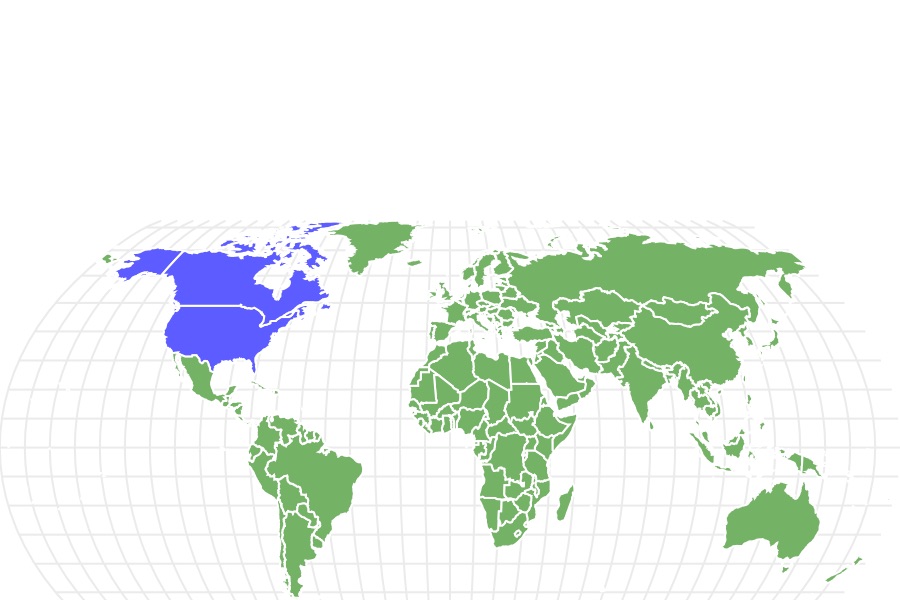Advertisement
Cephalaspis Scientific Classification
- Kingdom
- Animalia
- Phylum
- Chordata
- Genus
- Cephalaspis
- Scientific Name
- Cephalaspis lleyli
Read our Complete Guide to Classification of Animals.
Cephalaspis Conservation Status
Cephalaspis Facts
- Diet
- Omnivore
Cephalaspis Physical Characteristics
View all of the Cephalaspis images!
Introduction
The cephalaspis (meaning “head shield”) is a fossilized genus of fish that lived during the early Devonian Period. This was roughly 416-359.2 million years ago. These were heavily armored fish that defended themselves against predators such as the placoderms and eurypterids. The cephalaspis lived in a calcium-poor freshwater habitat. The habitat includes a variety of different extinct species, with around 20 species.
Description & Size

The cephalaspis was a primitive and jawless invertebrate that resembles a modern fish, and they were found throughout Europe and
North America
in lower Devonian rocks.
©1,980 × 1,040 pixels, file size: 514 KB, MIME type: image/jpeg – License
The cephalaspis (meaning “head shield”) is a fossilized genus of fish that lived during the early Devonian Period roughly 416-359.2 million years ago. These were heavily armored fish that defended themselves against predators such as the placoderms and eurypterids. The cephalaspis lived in a calcium-poor freshwater habitat. This habitat includes a variety of different extinct species, with around 20 species.
The cephalaspis was a primitive and jawless invertebrate that resembles a modern fish. One can find fossils throughout Europe and North America in lower Devonian rocks. They belonged to an early group of invertebrates called ostracoderms. Ostracoderms had a poorly ossified skeleton and bony head shield. The eyes of the cephalaspis were located on the sides of their flat heads with a ventral mouth placement.
They had strong tails although they were slow swimmers. Some variations of the cephalaspis even had horns on their heads. These horns were actually hydrodynamic adaptations. The adaptations allowed them to lift from the water currents that flow over their body that they could passively control.
They had a large pair of pectoral fins and advanced sensory structures. These structures were an electric organ along their head shield. The cephalaspis was on the smaller side. They only grew to be between 7 to 11 inches (20 to 30 cm) in size.
Diet – What Did Cephalaspis Eat?
The creature’s head shape and physical structure indicate that they were bottom-dwelling vertebrates. They likely spent most of their time foraging in muddy substrates for food. Their diet possibly included worms and crustaceans that they would dig up. The cephalaspis also sifted through detritus for food, and their lack of jaw did not allow them to bite.
Their body structure is quite similar to the catfish and Plecostomus we see today. Both creatures have armored bodies and bottom-sucking mouths. They hang around the bottom of an aquarium or body of water like the cephalaspis did.
The eating habits of the cephalaspis made them a predator. Cephalaspis dined on a carnivorous diet of worms, crustaceans, and detritus. They possibly ate loose vegetation that sunk down to the bottom of the riverbed.
For the cephalaspis to hunt, they would move from side to side to stir up the sand and mud. Stirring up the bottom gave them access to their food. This is a form of hunting that the cephalaspis used to look for food.
Habitat – When and Where It lived
The cephalaspis inhabited freshwater rivers, which were shallow considering they lived at the bottom of the riverbed. The rivers or other freshwater estuaries had a soft sandy or muddy texture. The bottom materials made it comfortable for the cephalaspis to swim over. They are freshwater vertebrates and do not inhabit marine environments.
They lived during the early Devonian Period. This period existed around 416 to 359.2 million years ago and was the age of the fishes. The Devonian Period was a warm period that did not have many of the waters affected by cold glaciers. The climate that the cephalaspis tolerated was warmer than what we experience now, which means that their aquatic habitats were quite warm.
This makes them comparable to the Plecostomus and many catfish species that live in modern aquariums, as they prefer warmer temperatures which can be achieved through heating equipment. The evolution of the cephalaspis gives researchers great insight into how many fish-like vertebrates have evolved over millions of years to the modern varieties we see today, even having similar environmental requirements in terms of habitat and diet.
Threats And Predators
The cephalaspis was a predator itself, and their heavily armored bodies made them able to defend themselves from other predatory fish. The heavily armored head protected them well since their slow-swimming habits wouldn’t make them fast enough to escape predators.
The horns and ridges along the creature’s head were not there as a defense mechanism but as a form of passive control in the water currents. These horns and ridges were not sharp or overly long, which indicates that they did little in terms of keeping predators away.
The main threats and predators the cephalaspis faced were other large predatory fish that lived during the Devonian Period, such as the Laccognathus embryi which was a carnivorous fish with 1.5-inch-long fangs, but it is still unsure which predatory fish made a meal out of the cephalaspis.
Discoveries and Fossils – Where It was Found
The first cephalaspis fossil was discovered in Old Red Stone in Britain during the early 19th century, but it is unclear who found the first fossil. Louis Agassiz was the one to name the cephalaspis fossil in 1843 and it was described as one of the last jawless fish to exist.
Fossils of the cephalaspis have been found throughout Canada, Ukraine, and other parts of the United Kingdom and the United States, and Europe. The cephalaspid fossils are only found in freshwater sediments such as lakes and deltas, and even marine sediments even though they were not marine creatures.
Louis Agassiz placed the cephalaspis into four different species – C. lyelli, C. rostratus, C. lewisi, and C. lloydi. It was later known that the last three species were not truly cephalaspis but rather described as the heterostracan Pteraspis. Several species have been moved from the cephalaspis genus; however, some species have not yet been moved and all species from this genus are extinct.
Extinction – When Did It Die Out?
The cephalaspis went extinct after the early Devonian Period which erased most of the aquatic creatures at the time. Since the Devonian Period was a warm period, the creatures likely died due to global cooling when more glaciers formed and caused the water to cool beyond what was tolerable by the cephalaspis.
The mass extinction was also likely caused by rising sea levels and an anoxic event known as the Hangenberg event occurred. Rising sea levels and glaciation caused the cephalaspis genus to die out and it is considered to be the second-largest extinction of the Devonian Period around 358 to 400 million years ago. This event caused almost all life in the ocean to meet their demise, including all species of the cephalaspis genus.
Similar Animals to The Cephalaspis
There are few animals similar to the cephalaspis, however, they are most comparable to modern-day catfish or Plecostomus. They both share body armor and are bottom-dwelling fish with a sucking mouth structure at the bottom of their face.
- Catfish- Armored bottom-dwelling fish with a suction mouth placed underneath their head.
- Lamprey- Extinct lineage of jawless fish with a funnel-like sucking mouth.
Cephalaspis FAQs (Frequently Asked Questions)
When was the cephalaspis alive?
The cephalaspis was alive 416 to 359.2 million years ago during the early Devonian Period. They lived in freshwaters such as lakes, rivers, and deltas. This was the period of fishes, and the cephalaspis is one of the late jawless fish that existed at the bottom of the riverbeds.
They went extinct millions of years ago due to global changes, such as glaciation and rising sea levels possibly from melting glaciers that cooled the water.
How big was the cephalaspis?
The cephalaspis was not very large, as they only grew to be between 7 to 11 inches (20 to 30 cm) in size. They are about the same size as the modern-day Plecostomus and both creatures share some similarities.
Is the cephalaspis a bottom feeder?
The cephalaspis was a bottom-dwelling vertebrate that spent its time at the bottom of water estuaries where they would forage for food in substrate by moving side to side. Their body structure such as a suction mouth underneath their head made them a bottom feeder and they lacked a jaw that would allow them to bite down on their prey.
What did the cephalaspis eat?
The jawless cephalaspis was a carnivore and predator that ate worms, crustaceans, and detritus stirred up in the substrate from moving their bodies. They would also dig in the substrate with their mouthpiece to loosen up the dirt to expose hiding worms and crustaceans’ underneath which they would suck on to eat.
Thank you for reading! Have some feedback for us? Contact the AZ Animals editorial team.
Sources
- Wikipedia , Available here: https://en.wikipedia.org/wiki/Cephalaspis
- Palaeontology world, Available here: https://paleontologyworld.com/exploring-prehistoric-life-curiosities/cephalaspis-silurian-devonian-jawless-fish-were-ecologically
- Fossil hunters, Available here: https://www.fossilhunters.xyz/amphibians/jaws.html#:~:text=Cephalaspid%20fossils%20have%20been%20found%20in%20freshwater%20sediments,their%20bodies%20along%20with%20the%20muscular%20pectoral%20fins.

















